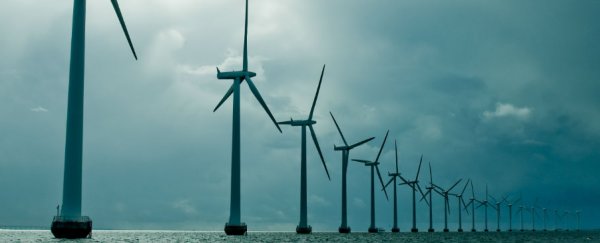On a particularly windy day last week, Denmark's wind farms produced between 116 and 140 percent of the national electricity requirements, and they weren't even operating at their full 4.8GW capacity at the time. Eighty percent of the excess was shared by Germany and Norway, and Sweden got 20 percent of the spoils, showing just redundant fossil fuels can be if governments make the commitment to renewable energy sources.
"It shows that a world powered 100 percent by renewable energy is no fantasy," Oliver Joy from the European Wind Energy Association said in a statement. "Wind energy and renewables can be a solution to decarbonisation - and also security of supply at times of high demand."
Denmark has long been an advocate for the benefits of wind power, and just last year managed to generate a record-breaking 39.1 percent of its national electricity needs from wind. Last week, it made an even greater achievement: a high of 140 percent of its national electricity needs, helped along by some unexpectedly severe weather.
"On an unusually windy day, Denmark found itself producing 116 percent of its national electricity needs from wind turbines yesterday evening," Arthur Nelson reports for The Guardian. "By 3am on Friday, when electricity demand dropped, that figure had risen to 140 percent."
The figures were verified by energinet.dk, a Denmark-based website that tracks the ratio of renewable versus fossil fuel-based energy being fed into the national grid.
While the country can't rely on wild and woolly weather to sustain it all the time (I'd imagine if it was hit with winds travelling at 93 km/h on a regular basis, it'd soon have no energy requirements at all on account of everyone jumping ship), it's been steadily increasing its wind farm output by 18 percent each year to take advantage the what wind it does get on a regular basis.
Right now, Denmark is getting a third of its overall electricity needs from off-shore wind farms, The Guardian reports, but it's well on its way to getting that share to 50 percent - and it expects to hit that well before its target date of 2020.
Denmark's great success with wind is awesome news, but it also makes the recent announcement by the Australian government that the state-owned Clean Energy Finance Corporation (CEFC) would be ceasing all investments in wind and small-scale solar power projects look even more suspicious. Especially since it's at complete odds with what the Australian public would actually prefer, as Peter Chan reports for the ABC:
"According to Essential Media polling conducted in May, 71 percent of Australians support more emphasis on solar power and 62 per cent support more emphasis on wind power. Only 4 percent and 6 percent, respectively, preferred less emphasis on these forms of energy."
I guess we'll all just have to move to Europe.
